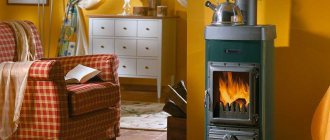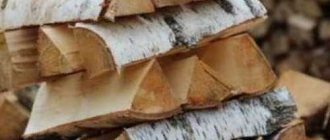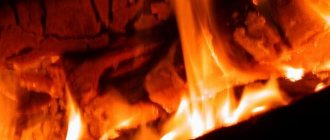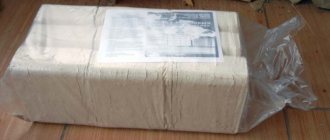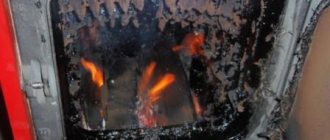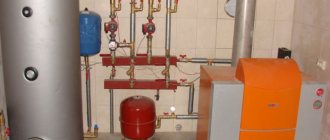Best answers
Zhanna K:
The neighbor's house is 6*6, that is, 36 square meters, made of timber, with an attic, he took 10 cubic meters last year, that is, Kamaz in bulk, it was barely enough for the winter, that is, 2 Kamaz trucks will probably be enough for you. The stove is also Butakova, it was always warm in the house.
Mikhalych:
it’s easy to calculate from the daily “norm” 80-120 liters per day passport request x for 30 x 8 months = 19 - 29 m3 WAREHOUSE (!) i.e. folded, not cubed from round timber...)))))
Anaida Zagoskina:
A lot depends on the stoves that heat your home. As a rule, such a room cannot be heated with one stove. If you have a baker and a stove, that is, two ovens, then 10 cubes will be enough. Heat the baker in the morning, and heat the stove or floods closer to lunch. The average temperature in the living space will be maintained constantly. If the bakery has a good chimney, then the additional stove can be heated in the evening.
Nikita:
I live in the north, a house of 90 square meters, 150x150 timber, a brick stove with a homemade water boiler, enough for 10 cubic meters (unsawn) for the whole winter + a bathhouse in winter 2 rubles a week, in summer every day. If you can do better with this crap, feel free to scrap it
Sergey Bogatyrev:
house 40 m 17 cubic meters but this is with a margin
How much wood is required to heat a house?
We always look at the quality of the firewood we buy. Soft wood burns quickly, but does not produce much heat. Preference is given to hard rocks, which, although they burn slowly, provide a lot of heat to the project. Rotten firewood very often comes across on sale. When you prepare firewood yourself, this will never happen. And most often they sell raw wood.
It turns out that for a private house or cottage it is best to find about 10 cubic meters of firewood for the season. In order not to spend money on buying chopped firewood, you can start harvesting it yourself. Moreover, near the summer cottage there will always be a forest where there is a fallen old tree. An excellent option for preparing firewood is to take advantage of the moment when someone is dismantling an old wooden house.
Equipment for preparing firewood for the winter
You cannot prepare a lot of firewood with a hacksaw or an ax. In addition, you need to put in a lot of effort.
In order to carry out preparation work, you need to buy special tools, of which there are not so many.
In order to cut a tree trunk in the forest, you need to choose a good chainsaw. The best option is a device with a power of up to two kilowatts. If the work will be carried out near the house, then there is an option to use an electric saw. There are types of saws on sale that are equipped with batteries. If the work will be carried out very often, it is recommended to buy semi-professional saws. Their power is higher than two kilowatts, and their price is higher.
Then, to chop firewood, you need to buy a high-quality horizontal type wood splitter. For the home, this is the best device that works safely. Working with a wood splitter is simple: you need to turn on the device, which runs on electricity, then put in a log, and then wait for the knife to split it.
There will be trash after the work. And here you will need a shredder that can be used to process the waste. Wood chips, shavings, and leaves can be quickly turned into fertilizer for the garden.
If you want to purchase high-quality equipment, you will have to shell out a lot of money. However, the tools will last a long time. After a while they will fully pay for themselves. For those who think that buying ready-made firewood is cheaper, they are deeply mistaken. For example, what does it cost just to deliver ready-made firewood, and then you also need to store it. Firewood is stored under special sheds or in woodpiles.
Do-it-yourself firewood shed at the dacha, photo
Sheds for storing firewood in winter at the dacha
shed for storing firewood in winter
Experts have proven that self-harvesting wood is much cheaper for the owner, even if he has spent significant amounts of money on purchasing garden equipment.
What are energy-saving solid fuel boilers?
Let's try to understand what energy-saving solid fuel boilers are, and what meaning manufacturers put into this phrase when they indicate it in their advertising brochures and on websites.
Any economical solid fuel boiler will already be “energy saving” - you will burn wood in it with better efficiency than in a regular “boiler”. That is, it will save energy - this is an axiom. This means that we put all high-efficiency solid fuel boilers in this category.
No top-secret technologies are used in the production of TT boilers. Good engineering calculations, well-calculated heating engineering and advanced knowledge of strength materials - that’s all that is required to design the right solid fuel heat generator.
Next, technology comes into play, modern machines and welding, and production workers interested in their work.
I am inclined to attribute the tale about “energy-saving boilers” to marketing ploys. When a product does not have good real characteristics, “defense industry products” and “by-effects of space technology” are born.
Fireplaces and fireplace inserts cost savings, highest quality and convenient purchase
Fireplaces and fireplace inserts for heating – features of selection and application:
When choosing a fireplace, you should understand that it is primarily a heating device. That is why its acquisition should be taken with the utmost seriousness.
It is important to consider the technical capabilities, purpose and design features of the models you choose. You also need to remember that fireplace inserts from different manufacturers differ significantly from each other in precisely these indicators
Despite this, externally, fireplace inserts can be very similar.
How to reduce home heating costs?
Fireplace inserts can perform the function of heating equipment: be both the main and auxiliary source of heating in the house. But not every fireplace insert can heat a house. Fireplace inserts can be either for decorative purposes (with intermittent combustion) or with a heating function (continuous combustion).
Two types of functional fireplace inserts will help you save on heating your home:
- – with air heating;
- – with water heating.
To heat a water heating system, you need to buy a fireplace with a water circuit. It will perform the work of a solid fuel boiler and fireplace at the same time. Most often, a water fireplace is used in a system with another heat source, for example, a gas or electric boiler. When the fireplace is operating, the other source is automatically switched off. A fireplace with a water circuit can also independently heat the entire house. This saves money on heating your home.
The efficiency of a fireplace-based air heating system depends on many factors:
If it is not possible to install a traditional wood-burning fireplace, and the dream of home comfort with a fireplace does not leave you, we suggest buying an electric fireplace with a 3D flame effect. For country houses or cold rooms, free-standing fireplaces and stoves that do not need finishing are ideal. We can also offer you stoves for baths and saunas.
To purchase a fireplace and order its installation:
You can send us a house plan by email, or order a visit from our specialist to take measurements on site. We will make you a free commercial offer for a fireplace heating system, which will indicate all the necessary equipment.
A good fireplace can really heat up your home quickly. You won't turn your beautiful living room into a boiler room, since you won't have to add wood to the fireplace every hour. Our fireplace inserts allow one load of wood to burn for a long time, even up to 12 hours.
You can buy fireplaces, fireplace inserts in Ukraine or other products presented by us by ordering them by phone or through an online store. In all cities of Ukraine we deliver by transport service.
Our main advantages:
- – individual approach.
- – only high-quality goods.
- – direct deliveries from the manufacturer.
- – official warranty from the manufacturer for up to 10 years.
- – shortest delivery and installation times.
- – affordable prices for fireplace inserts.
Which firewood is better
The wood that serves as raw material for firewood is far from identical in its properties.
Hard wood species such as birch, oak, hornbeam, beech, and yew burn hotter, have a high fibrous density, and burn more slowly.
Soft varieties have their advantages, for example: aspen produces 25% less heat than birch, but it perfectly maintains heat in a heated stove. Alder still shares a delightful aroma, as do coniferous varieties. Alder and aspen, added to the stove at the end of heating, remove soot and soot deposits in the chimney. But the formation of plaque, which can lead to clogging of the chimney, occurs during the combustion of essential oils and resins of pine, fir, and spruce. Conifers are also inferior in calorific value to birch and oak, but they dry out faster and are more suitable for kindling. Only fir sparks strongly, and larch emits a lot of carbon monoxide at the end of combustion and you need to be more careful with the damper.
Some types of fruit trees are classified as medium-hard wood and their calorific value is average. They burn, emitting an aroma, and are easy to prepare, since the wood can be split without much effort.
Based on the above, it is difficult to recommend any one type of wood for stove or fireplace firewood. As fuel, hard deciduous tree varieties are the most efficient. Even flame, high heat output, less soot and ash. But the aroma of coniferous trees has a therapeutic effect, and is well suited for lighting. By combining several varieties, it is possible to maintain both the working condition of the chimney, stove, and a comfortable microclimate throughout the cold period, subject to the initial investment in a good one. Otherwise, any heat, along with your funds, will fly into the pipe and evaporate through the cracks.
Initial data for calculation
The calculations themselves, which determine the amount of wood burned in the boiler firebox, are quite simple. The difficulty is to choose the right source data to perform the calculations. Of course, the easiest way is to use some online calculator that is posted on various Internet resources, and thus find out for yourself the rates of firewood consumption for heating your home. There is only one way to check the correctness of the calculation: do it yourself, manually.
For this reason, we initially suggest going this way, then you will be confident in the result. But you can check its correctness using several online calculators. Below we will present the methodology and at the same time, as an example, we will calculate the consumption of the amount of firewood for heating a house of 100 m2. But first of all, the initial data, here is their list:
- the type of wood that is supposed to be used to heat the premises;
- their degree of humidity;
- Efficiency of a solid fuel stove or boiler;
- thermal power required to heat the building.
Those who have ever used a stove have probably noticed that when burning wood from different trees, different amounts of heat are released. For example, birch logs produce more heat than poplar or pine. This happens because different tree species have different densities and calorific values. Also, the amount of firewood per 1 kW of thermal energy depends on its humidity. The higher it is, the more heat is spent on evaporating water from the fuel, and less is left for heating the house. As a result, more wood will be needed to heat the home.
The efficiency of using the energy contained in wood depends on the efficiency of a particular heat source. For example, a fireplace or a conventional stove releases a lot of energy into the atmosphere along with combustion products, respectively, their efficiency does not exceed 60%. Another thing is a solid fuel or pyrolysis boiler, whose efficiency can reach 80%; these features must be taken into account when calculating the cost of heating a private house.
The table below provides reference data on the calorific value of 1 m3 of certain types of wood at a certain humidity.
Note. The table shows the values for a “net” cubic meter of each type of fuel; the cubic capacity of firewood must be calculated using 1 m3 of logs or logs stored in storage, which will be discussed below.
The value of the thermal power required to heat a home is best taken according to the calculation made by specialists during the design of the house. But often homeowners do not have such data; in this case, the amount and cost of firewood for heating can be calculated based on the average value of the required power. It is determined by a well-known method: heating 10 m2 of premises requires 1 kW of heat under the most unfavorable conditions, and on average per season - 0.5 kW. That is, the average standard for a house with an area of 100 m2 will be 5 kW/h.
Amount of firewood for winter
One of the paradoxes of the universe: the more ordinary and familiar an object of natural origin, the more complex its mathematical description. In order to calculate the volume of a Galaxy or star, it is enough to remember a school geometry course. If someone really needs to know the exact volume of a log, it is impossible to do without differential calculus methods. Because of an astronomer's mistake, the average person is neither hot nor cold; But if the fuel reserves for the winter are incorrectly calculated, the cold in the house is ensured.
Everything seems simple: we multiply the duration of the heating season in days by the area of the house and the average daily consumption of firewood. Do not believe this simplicity, it is deceptive and requires many clarifications. In fact, it is also necessary to take into account the height of the ceiling, i.e. not area, but volume. The most interesting thing begins when it comes to the average daily consumption of firewood. This value depends on the calorie content of the fuel, the efficiency of the furnace, climatic conditions, heat loss and many other factors, including the radius of curvature of the master’s hands. The last parameter is an irrational value that can reduce heating efficiency to zero. If you set out to derive a universal formula for accurate calculations, there will be enough material for more than a dozen dissertations. It is much faster to make inquiries from neighbors or former owners of the house.
If you are planning to install a solid fuel boiler, it is easier to calculate its “appetite” - the main technical characteristics are known. The easiest way to get an approximate figure is to use formulas or online calculators posted on specialized websites.
Let's try to calculate.
As a standard, let's take a house with a total area of 150 square meters. m and insulated according to SNiP. In the coldest time, about 100 W/m² will be needed to heat the room. Let's take the average energy consumption as 50 W/m². The heating season lasts 7 months (214 days). With continuous heating we get:
150 m²•50 W/m²•24 h•214 days = 38.52 MWh, which approximately corresponds to 33 Gcal.
The specific lower heat of combustion of absolutely dry firewood is 4440 kcal/kg. During natural drying for about two years, the residual moisture content of the wood is 20%, the specific heat of combustion is 3400 kcal/kg. Let us take the efficiency of a solid fuel boiler to be 70%.
We calculate the required amount of firewood: 33000kcal•1000/3400kcal/kg/ 0.7/0.730 kg/m³≈19 m³, where 0.730 kg/m³ is the density of oak wood. In terms of maple or birch, the required value is 21.3 m³, and for pine – 26.4 m³. In practice, you may need less or more firewood, depending on the state of the house’s thermal insulation and weather conditions.
All-knowing statistics claim that to heat a small insulated log house in central Russia, 4-6 cubic meters of firewood per season is sufficient. The most economically justified supply of firewood is for two or three seasons: current + 1-2 next. In this case, you will probably have enough fuel even for the longest cold period. Another argument: firewood, like good alcohol, only gets better over time.
“God have mercy, what kind of firewood? We are civilized people, we have gas!” – this position is fundamentally wrong. Firstly, because we have the good fortune to live in the most amazing country in the world. Here, from time immemorial, two scenarios have been observed: the unlikely and the worst. Secondly, the civilized world is returning to proven and, most importantly, renewable energy sources. Firewood, straw and peat are all the same as hundreds of years ago, adjusted for modern technology.
Having a solid fuel boiler and at least a year’s supply of firewood in a gasified house is not a whim, but a completely reasonable solution. Optimism is good, but optimism backed by strategic reserves is twice as good.
You can also use our online calculator to calculate the amount of chopped wood for heating a country house, cottage or bathhouse.
How much firewood do you need?
Let's try to calculate how much firewood is needed for the winter to heat a country house or other premises, such as a bathhouse or garage. Nowadays, the amount of firewood is measured in cubes. 1 cubic meter can be converted into kilograms and the weight of a cubic meter of firewood can be converted into the heat received - kilocalories. Calculating firewood consumption seems simple, but often requires many clarifications. As a rule, to determine the amount of firewood for the winter, multiply the duration of the heating season in days by the average daily consumption of firewood for a certain area of the house. It is more correct to take into account not the area of the heated house, but its volume, taking into account the height of the ceiling in the house. When calculating the average daily consumption of firewood, many indicators can be taken into account, such as the caloric content of wood fuel, the efficiency of a wood-burning stove, heat loss and climatic conditions, especially during the winter heating period.
The calculator determines the consumption in cubic meters, depending on the type and moisture content of the firewood, the area of the heated house and the heating period:
The most useful and economical in terms of consumption for generating heat is considered to be firewood that has been lying in the open air under a canopy for one or two years. The humidity of such firewood is approximately 15-20%. Therefore, a reserve is absolutely justified not for one winter, but for two or three seasons (the current one and the next 1-2). How much firewood reserves were made in spring and summer directly determines how much firewood will be needed in winter. Just like good alcohol, wood gets noticeably better over time.
Initial data used in the firewood consumption calculator:
When choosing firewood for a fireplace or stove, humidity is of great importance. The calorific value primarily depends on humidity. It is believed that logs with a humidity of no more than 25% are best for heating. The table shows calorific value indicators (the amount of heat when burning 1 kg of firewood depending on its humidity):
| Wood humidity (%) | Calorific value (kcal) | Notes |
| 15 | 3634 | kiln-dried firewood |
| 20 | 3381 | one-year-old firewood under a canopy |
| 25 | 3128 | |
| 30 | 2875 | |
| 40 | 2622 | |
| 45 | 2116 | |
| 50 | 1863 | freshly cut firewood |
The wood consumption when burning a fireplace or stove is also affected by the density or hardness of the wood. The table shows the density of wood at a humidity of 12%:
| Wood species | Density (g/cm3) |
| Spruce | 0.45 |
| Aspen | 0.51 |
| Pine | 0.52 |
| Alder | 0.55 |
| Birch | 0.65 |
| Cherry | 0.66 |
| Larch | 0.66 |
| Oak | 0.69 |
Specific calorific value of various types of wood:
| Wood species | Mass heating value (kcal) | Density of dry wood (g/cm3) | Specific calorific value (kcal) |
| Oak | 4857 | 0,64 | 3108 |
| Birch | 4919 | 0,57 | 2804 |
| Pine | 5064 | 0,42 | 2127 |
| Alder | 4878 | 0,43 | 2097 |
| Spruce | 4857 | 0,38 | 1846 |
| Aspen | 4779 | 0,37 | 1768 |
When calculating costs, the efficiency of a wood-burning stove is assumed to be 70% and heat loss during heating is minimal. The ceiling height in the house is taken to be the statistical average. If you need to calculate how much firewood is needed for heating during the coldest winter in recorded history for a non-standard private country house, use a firewood consumption calculator, applying corrections to it.
www.lesdrov.ru
Answers from experts
New:
1 cart (4 cubes/4t. rubles) economy, 2 from the belly. But this is provided that there are no cracks, the winter frames are perfect, the ceiling is insulated, and the Russian stove is in working order.
Rada Simbireva:
!0 cu. enough meters. This is approximately 4-5 thousand rubles, depending on the area and the presence of forests in the area.
Lyudmila Demina (Malakhova):
Well. and the men went... Buy a car of wood and burn it, and then draw your own conclusions!
INFERNO:
The amount of firewood depends not on the area of the house, but on its volume. with a ceiling height of 2 meters and 2.5 meters, the difference in the volume that needs to be heated is 100 cubic meters, which is decent. In addition, you need to know what material the house is made of, its heat-retaining ability, and the characteristics of the heating device (stove or boiler). The price of wood depends on the type of wood, sawn or chopped. We sell chopped birch from 1200 to 2500 per cubic meter, depending on the distance from the city and the number of wealthy homeowners in the area.
Nadezhda R:
If we assume that 6 m3 can be stored in a car, then for the winter you need 2 cars, i.e. 12 m3. Our car of firewood costs 6 thousand. Yours may be cheaper...
Elena the beautiful:
If with coal, then 3 cubic meters is enough. Machine-5-6 cu. costs 5-6 thousand. Tambov region. It depends on what kind of winter it will be, of course.
ZhenYok:
it depends on what kind of house it is, big or small, warm or cold, and also on the type of wood, pine burns quickly, gives little heat, aspen is the same, the best choice is birch. I have a five-walled house, the house is closer to a warm one, I need about 1 car (about 5 cubic meters) of birch firewood, this is the minimum, pine so at least two cars
irina gurlova:
And where do you live? In winter it’s +5 here, but there are places that are even colder.
Cyber Phantom:
I wonder how to compare the units “cubic meters” and “little by little”? Apparently you need to know the area of the heated room.
Eugenio DJ:
Depends on how big the stove is. 4-5 cubes are enough.
Tiger:
You need six cubes.
wavan:
365 if you throw it up every night
Antonina Smirnova:
This depends on the winter temperature, the heated area, the quality of the firewood and the length of the heating period. I don't know your details. in Siberia, my mother bought 30 cubic meters of birch firewood. in the Far East, where winter is much shorter, we bought 15 cubic meters. - taking into account that we had a farm and had to cook food for the animals.
SpecWood -:
There are many parameters to take into account, here’s a calculator:
Resolution of the Head of the Novopokrovsky rural settlement of the Novopokrovsky district dated 02/04/2009 N 10
Text of the legal act as of August 2012
In accordance with Decree of the Government of the Russian Federation of May 23, 2006 N 306, taking into account the caloric content of fuel, I decide:
1. Approve solid fuel consumption standards per month of the heating period: coal - 8.5 kg/sq.m, firewood - 0.025 cubic meters/sq.m.
2. Entrust control over the implementation of this Resolution to the deputy head of the Novopokrovsky rural settlement for improvement issues N.P. Kovalya.
3. The resolution comes into force on the day of its official publication.
Head of the Novopokrovsky rural settlement M.I. GRECHUSHKIN
Appendix to the Resolution of the head of the Novopokrovsky rural settlement dated February 4, 2009 N 10
SOLID FUEL CONSUMPTION STANDARDS
——+———————-+——————+——————- ¦ N ¦ Indicator ¦ Per month ¦ In heating ¦ ¦ ¦ ¦ heating ¦ period (based on ¦ ¦ ¦ ¦ period ¦ 6 months) ¦ +—-+———————-+——————+——————+ ¦ 1. ¦Coal supply standard ¦ 8.5 kg/sq.m ¦ 51 kg/sq.m ¦ +—-+———————-+——————+——————+ ¦ 2. ¦Firewood supply standard ¦0.025 cubic meters/sq.m ¦ 0.15 cubic meters/sq.m ¦ ——+———————-+——————+——————-
To calculate the standard for thermal energy consumption per 1 square meter of total area, Decree of the Government of the Russian Federation of May 23, 2006 N 306 (formula 2) was used, taking into account the calorific value of the fuel.
Methodological guidelines of the State Unitary Enterprise of the Academy of Public Utilities named after. K.D. Panfilova (2002, edition 4).
Formula for determining the heating standard (formula 2) (coal)
The heating standard (Gcal per 1 sq.m. per month) is determined by the formula:
Qо Qо No = ——- = —— x 2 = 0.0375 Gcal/sq.m (heating period), S x 12 S x 12
Where:
Qо - the total consumption of thermal energy for heating the residential premises of an apartment building or residential building, determined as the sum of the readings of collective metering devices for the heating period (Gcal) (for 12 households it is 91746.6 Gcal);
S - total area of residential premises of an apartment building or premises of a residential building (sq.m) (for 12 households it is 408,282 sq.m).
P = N x S (Gcal/month).
The average caloric equivalent value for converting natural fuel into conventional fuel for coal from the Donetsk basin is 0.94.
P x 213.2 A = ————, kg (per month/sq.m), 0.94
where 213.2 is Donetsk coal (production of 1 Gcal of heat kg of standard fuel);
0.94 is the equivalent of converting natural fuel into conventional fuel and vice versa.
Necessary thermal energy costs for the heating period:
tin — tср Qо = G x ———— x T (Gcal/heating period), tin — tro
where G is the total heat load for heating residential buildings (heating period) (for 12 households it is 54258400);
tin — internal air temperature of heated residential premises (18°C);
tro is the estimated outside air temperature for design purposes (for Novopokrovskaya -22°C);
tsro - average monthly temperature during the heating period (2.57°C);
T - hours during the heating period (4392).
8.5 x 6 = 51 kg/sq.m.
To calculate the rate of firewood consumption for heating residential households, due to the lack of individual standards, fuel consumption rates in kg of equivalent fuel are accepted.
What you need to know to calculate
Before calculating fuel for the entire season, you need to clarify a number of points, since firewood consumption depends on several factors. Here is a list of questions that require answers:
- How much heat is needed to heat a country house in your area of residence?
- What type of wood is planned to be burned?
- What is the moisture content of this wood? Is it freshly cut, semi-dry, or has it been around for a year or two?
- What is the efficiency (COP) of your heating unit? Indicated in the passport for a solid fuel boiler or stove.
You might say that rather than collecting all this data, it’s easier to use an online fuel consumption calculator. But not everything is so simple; the calculators presented on various sites are programs written by people. The calculation results must be checked to ensure their correctness. The best way is to calculate the amount of firewood and the cost of heating yourself, and then, to be sure, you can run the numbers on any online calculator.
Thermal energy consumption for heating a private home is determined by calculations performed by specialists or by an aggregated calculation method. For most homeowners, the second option is more acceptable, since you have to pay for the first. Its essence is this: on the coldest days, 10 kW/h of heat is allocated to heat 100 m² of building area located in a temperate climate zone. Taking into account the temperature change during the heating period, the average consumption during the season will be 5 kW/h.
Different types of wood release different amounts of thermal energy when burned, which is why it is important to know this in advance. The table below shows the calorific value of firewood of different types, referred to a measure of volume - 1 m³:
As can be seen from the table, the moisture content of wood fuel also affects the calorific value. The drier the wood, the more energy can be obtained per unit volume. This is understandable: when raw wood burns, part of the heat is spent on evaporating moisture and is not used to heat the house.
The efficiency indicator (EI) makes it clear what part of the thermal energy from burning fuel the boiler is able to direct into the heating system, throwing the rest into the chimney. This value is specified in the technical data sheet of each heat generator. For those who have not yet purchased a wood-burning heat source, here are the efficiency indicators for various heaters:
- when burning in a classic solid fuel boiler, 70 to 75% of the heat is used;
- the same, in a pyrolysis boiler - 80%;
- Russian brick or bell-type oven – 65%;
- steel or cast iron stove – no more than 55%.
Note. The efficiency value indicated for a pyrolysis heat generator corresponds to reality when working on dry wood (humidity 20%). If you “feed” this boiler with raw firewood, then its efficiency will not exceed 60...70%.
We buy firewood
Which firewood is more profitable to buy: split or round? loose or stacked? We suggest you look into this issue and save a lot, especially if firewood serves as the main fuel for heating your home.
Firewood is usually sold by the cubic meter. But, oddly enough, the cube is different from the cube. And this difference is noticeable. Let's start with the fact that the cubic meter of firewood that we buy is far from the true cubic meter. You have to pay not only for wood, but also for air in the literal sense of the word, because it is impossible to lay firewood without creating voids between them. Therefore, we purchase the so-called folded cubic meter, if the firewood is delivered folded, or bulk, if the firewood is piled in bulk.
To understand how many folded cubic meters will come out of the bulk ones, you need to multiply the volume of firewood by 0.8. The indicator will, of course, be approximate, because a lot depends on the size of the logs, and it is impossible to calculate how densely the firewood will settle. And yet, the mass of firewood from a bulk cubic meter will be approximately 20% less.
But which firewood is more profitable to buy - split or round?
At first glance, the answer is obvious: chopped firewood is smaller, so it is stacked more tightly - and there will be more stacked cubic meters. But here lies the catch. Conduct an experiment: chop a few logs and the volume of the woodpile will increase. This is noticeable even with the most careful stacking of firewood. A natural question arises: will the seller waste time and resources on such dense loading? Never! This means that the losses will be greater.
To fix the difference between a cube of chopped and unchopped firewood, GOST introduced full wood coefficients, which establish the relationship between the volume of firewood and the full cube of wood. This means that it is enough to carry out simple calculations. It is necessary to multiply the volume of firewood by the full wood coefficient. This indicator depends on the length, size and type of logs or logs. To determine the exact value of the coefficient, we suggest using the following table.
The table shows that from one cubic meter of average hardwood logs 0.25 m long, 0.8 m3 of real wood comes out. From split logs with the same indicators you will get 0.76 m3. The difference from each cubic meter is 0.04 m3.
By the way!
GOST coefficients are valid for the most dense stacking of chopped firewood. If the wood in the brought woodpile is stacked in a well, supposedly for better drying, then you are being led by the nose - ask for a new measurement of the cubic capacity of the firewood.
When talking about the benefits of certain firewood, one cannot ignore their cost. Pricing principles among sellers may differ, but there are still some average indicators. More expensive than the others are stacked chopped firewood. Their average price is 1,500 rubles. for 1 m3. Chopping firewood in bulk will cost about 100 rubles less. The stacked logs will cost the same. A cubic meter of logs in bulk will cost about 1,300 rubles. for 1 m 3.
Which firewood to choose
The smallest amount of firewood will be obtained when ordering chopped firewood in bulk. For clarity, let’s calculate the value of the folded measure from the bulk one, and then calculate the true volume of firewood, taking the already familiar indicator of 0.76 as the full-wood ratio.
So, we get: 1 m 3 x 0.8 * 0.76 = 0.6 m 3
That is, when ordering a bulk cube of chopped firewood, in its pure form we get a little more than half a cube of wood for about 1,400 rubles. A full-wood cube in this case will cost 2,333 rubles.
Buying a bulk cubic meter of logs, following the same calculations and using the full wood coefficient for unsplit firewood, we get 0.64 cubic meters of real wood for 1,300 rubles. Here the cost of a full-wood cube is 2,031 rubles.
From a purchased cube of stacked chopped firewood, approximately 0.76 m3 will come out, costing 1,500 rubles. Total: 1,973 rub. for a full wood measure.
A similar volume of stacked logs (unsplit firewood) will yield 0.8 m3 of real wood. At a cost of approximately 1,400 rubles. a full-wood cube will cost 1,750 rubles.
You can save money by chopping your own wood. If you use hired labor, you will have to add the cost of the work, but you need to add it not to the final price of a full-wood cube, but to the cost of the purchased cubic meter. By the way, after chopping firewood, you will be left with a nice bonus - wood chips, which are sold for 100 rubles. per bag.
Lorem Ipsum is dummy text often used in printing and web design. Lorem Ipsum has been the standard text in Latin texts since the early 16th century. An unnamed printer at that time created a large collection of type sizes and shapes using Lorem Ipsum to produce type specimens. Lorem Ipsum has not only successfully survived five centuries without noticeable change, but has also entered electronic design. It was popularized in modern times by the publication of Letraset sheets containing Lorem Ipsum templates in the 1960s, and, more recently, by electronic typesetting programs like Aldus PageMaker which use Lorem Ipsum in their templates.
Why is it used? It has long been established that when evaluating design and composition, reading text interferes with concentration. Lorem Ipsum is used because it provides a more or less standard pattern filling, as well as a real distribution of letters and spaces in paragraphs, which is not obtained by simply duplicating “Your text here.. Your text here.. Your text here..” Many programs DTP and HTML editors use Lorem Ipsum as their default text, so a keyword search for “lorem ipsum” will immediately reveal how many web pages are still waiting to be born. Lorem Ipsum has received many versions over the years. Some versions appeared by mistake, some on purpose (for example, humorous versions).
Where did he come from? Many people think of Lorem Ipsum as pseudo-Latin words pulled out of thin air, but this is not entirely true. Its roots go back to a single fragment of classical Latin from 45 AD, more than two millennia ago. Richard McClintock, a Latin professor at Hampden-Sydney College in Virginia, took one of the strangest words in Lorem Ipsum, “consectetur,” and searched for it in classical Latin literature. As a result, he found the undisputed source of Lorem Ipsum in sections 1.10.32 and 1.10.33 of “de Finibus Bonorum et Malorum” (“On the Limits of Good and Evil”), written by Cicero in 45 AD. This treatise on the theory of ethics was very popular during the Renaissance. The first line of Lorem Ipsum, “Lorem ipsum dolor sit amet..”, comes from one of the lines in section 1.10.32
The classic text of Lorem Ipsum used since the 16th century appears below. Also given are sections 1.10.32 and 1.10.33 “de Finibus Bonorum et Malorum” by Cicero and their English translation by H. Rackham, 1914.
Lorem Ipsum is dummy text often used in printing and web design. Lorem Ipsum has been the standard text in Latin texts since the early 16th century. An unnamed printer at that time created a large collection of type sizes and shapes using Lorem Ipsum to produce type specimens. Lorem Ipsum has not only successfully survived five centuries without noticeable change, but has also entered electronic design. It was popularized in modern times by the publication of Letraset sheets containing Lorem Ipsum templates in the 1960s, and, more recently, by electronic typesetting programs like Aldus PageMaker which use Lorem Ipsum in their templates.
Why is it used? It has long been established that when evaluating design and composition, reading text interferes with concentration. Lorem Ipsum is used because it provides a more or less standard pattern filling, as well as a real distribution of letters and spaces in paragraphs, which is not obtained by simply duplicating “Your text here.. Your text here.. Your text here..” Many programs DTP and HTML editors use Lorem Ipsum as their default text, so a keyword search for “lorem ipsum” will immediately reveal how many web pages are still waiting to be born. Lorem Ipsum has received many versions over the years. Some versions appeared by mistake, some on purpose (for example, humorous versions).
Where did he come from? Many people think of Lorem Ipsum as pseudo-Latin words pulled out of thin air, but this is not entirely true. Its roots go back to a single fragment of classical Latin from 45 AD, more than two millennia ago. Richard McClintock, a Latin professor at Hampden-Sydney College in Virginia, took one of the strangest words in Lorem Ipsum, “consectetur,” and searched for it in classical Latin literature. As a result, he found the undisputed source of Lorem Ipsum in sections 1.10.32 and 1.10.33 of “de Finibus Bonorum et Malorum” (“On the Limits of Good and Evil”), written by Cicero in 45 AD. This treatise on the theory of ethics was very popular during the Renaissance. The first line of Lorem Ipsum, “Lorem ipsum dolor sit amet..”, comes from one of the lines in section 1.10.32
The classic text of Lorem Ipsum used since the 16th century appears below. Also given are sections 1.10.32 and 1.10.33 “de Finibus Bonorum et Malorum” by Cicero and their English translation by H. Rackham, 1914.
Void volume
What is the most common way to transport firewood? That's right, on old Russian-made trucks. And we know something about them. The body volume of the “53rd” “lawn” is 4.8 cubic meters. m. There is also a “collective farm” modification with high sides, then the volume increases almost 2 times. The volume of firewood in the body also depends on how it is stacked. But tell me, has anyone ever had neatly stacked firewood delivered to them?
They are almost always in bulk in the back. Well, accordingly, there is also a lot of empty space between the logs. However, there is nothing insurmountable for science in this ugly heap. because there is a special coefficient for converting the bulk volume into the volume of folded cubic meters. And it depends on the length of the log.
For example, for a 1/4 m log, the correction factor is 0.8. And for a log of 3/4 m - already 0.73. What does this wisdom mean for those who are not very good at mathematics? And the fact that 4 cubic meters of firewood with an average length of 25 cm, brought in bulk, after stacking will turn into 3.2 cubic meters.
Calculation of firewood consumption by a long-burning boiler
To calculate the consumption of firewood in a long-burning solid fuel boiler per day, use the following formula.
V = 24Q / (q x 0.01 efficiency) V – means the volume of firewood required for 1 hour, m³; Q – required power for heating, kW; q – thermal output of a certain type of wood with a specific degree of humidity, kW/m³; Efficiency is the efficiency of the boiler, in%.
Let's say you purchase a solid fuel pyrolysis boiler with a heat transfer rate of 75%. Load dry pine logs. The calculation will look like this:
V = 24 x 5 / (2166 x 0.01 x 75) = 0.074 m³.
When trying to correctly calculate fuel consumption in a pyrolysis boiler, you need to remember the nuances of its operation. An efficiency factor of 75-80% is displayed in the formula if the firewood has a maximum moisture content of 25%. If the indicator is higher, the boiler efficiency decreases to 70%.
The consumption of firewood in a long-burning solid fuel boiler for a month is done as follows:
0.074 x 30 = 2.22 m³
However, this is not the final result, since the formula involves the calorific value for a “clean” m³, and in fact, firewood in a woodpile takes up more space due to the packing density. To correctly calculate firewood in cubes, you need to know the number of storage meters.
GOST 3242-88, where the standard is specified, will help you carry out these calculations. In connection with this, stacked firewood must be measured, folding meters calculated, and then converted into dense meters, m³. the translation is made by multiplying the volume of the woodpile by the value of full wood.
Full wood coefficients for transferring folding measures back to back
| Length, m | Conifers | Hardwood | ||||||
| Round | Shattered | A mixture of chopped and round | Round | Shattered | A mixture of chopped and round | |||
| Thin | Average | Thin | Average | |||||
| 0,25 0,33 0,50 0,75 1,00 1,25 1,50 2,00 2,50 3,00 | 0,79 0,77 0,74 0,71 0,69 0,67 0,66 0,64 0,62 0,61 | 0,81 0,79 0,76 0,74 0,72 0,71 0,703 0,68 0,67 0,65 | 0,77 0,75 0,73 0,71 0,70 0,69 0,68 0,66 0,64 0,63 | 0,77 0,75 0,73 0,72 0,70 0,69 0,68 0,67 0,66 0,65 | 0,75 0,72 0,69 0,65 0,63 0,61 0,60 0,58 0,56 0,55 | 0,80 0,78 0,75 0,72 0,70 0,68 0,67 0,65 0,63 0,62 | 0,76 0,74 0,71 0,69 0,68 0,67 0,65 0,63 0,62 0,60 | 0,76 0,74 0,71 0,69 0,68 0,67 0,66 0,65 0,64 0,63 |
Since in our case there is an inverse problem, the fuel volume calculated above must be divided by one of the coefficients that corresponds to the present conditions.
Let's say we take chopped firewood 0.5 m long. For coniferous species, we need to take an indicator of 0.73. At the end, we calculate the real consumption of solid fuel from dry pine per month for a dwelling with an area of 100 m²:
2.22 m³ / 0.73 = 3.04 m³



